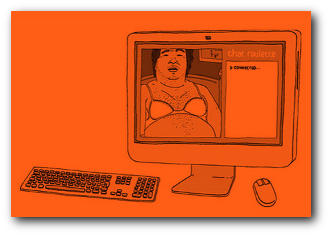Remote Research is a new book by Nate Bolt and Tony Tulathimutte, who have worked with the UX agency Bolt | Peters on a wide range of studies, with clients such as Wikipedia and Electronic Arts (I recommend watching the funny out-takes of Spore user testing).
Their new book sums up their experiences with performing remote research (Tony has previously discussed this subject on this blog, in the comments here), and gives clear instructions on how others can perform a wide range of usability and user experience studies with people who are physically distant, by using the internet.

Don't judge it by it's cover...
Why would you consider remote research?
Written by advocates of remote research, the book highlights many of the potential advantages that remote research gives compared to a more traditional lab based study. These advantages are fleshed out throughout the book through testimonies of experts who have experience in this field, who offer real world examples to emphasise these points.
Some key advantages are:
- Access to a geographically diverse user base. Unlike traditional research, where a moderator would have to be in the same physical location as the subjects, remote research allows a study to be run with anyone who has a high speed internet connection, widely expanding the potential study-group.
- Easy to let stakeholders get involved. Because the research session is being broadcast over the internet, it’s possible to allow stakeholders (i.e. executives and designers) to view the session, and give (moderated) input. This of course increases their engagement with the process, and will be the ‘evidence’ for any conclusions derived from the research.
- Natural browsing environment. The validity of the research can be improved, not only because you are allowing the user to perform the task in a familiar environment (their own home computer), but also some recruitment methods allow you to capture a user performing a task they have selected. For example, recruiting a user who came to the site to buy trousers, for a task based on buying trousers, would provide more accurate results than asking someone to pretend to buy trousers…
- Cheaper (debatably). Not having to pay for travel can keep costs down, however other costs, such as incentives, will still be required, as well as paying for the software.
The remote research book doesn’t advocate killing off lab tests though – instead, it recognises that there are cases when the lab is still appropriate, such as when privacy is a concern. The book also features Andy Budd’s defence of the lab, which argues that remote research fails to pick up aspects of non-verbal behaviour, as well as arguing that remote research doesn’t just remove a selection bias (geography), since it also adds another (internet speed and technical ability). It’s brave of the book to include the case against remote research, and helps project a more trustworthy and reliable image for the book itself.
How to do remote research
The ‘meat’ of the book are the sections dedicated to how-to guides on the different forms of remote research. The book contains step by step instructions on performing moderated or un-moderated research, and includes key topics such as recruitment (and live recruiting), card sorts, and lots of handy hints – such as using IM clients as a chat room for multiple observers to automatically share and timestamp notes.
The book doesn’t just cover basic topics – it goes on to develop novel approaches to user research, such as using ‘reverse screen sharing’ to protect confidential software or data, and using mobile web to gain a new understanding of time-dependant information, outside of the traditional moderated setting.
It also extends the remits of remote research – it doesn’t have to just be websites, but can include doodles or sketches, as well as developing ideas for automatic research with analytics.

Another sort of remote research?
Conclusion
Remote Research is one of the easiest to read UX books I’ve reviewed. Like many Rosenfeld publications, it is laid out well, without appearing dense with text, and has a friendly tone throughout. The book can be likened to Krug’s writing in its style, and presentation.
The book is also practical and realistic, and deals with real world issues, like ‘fakers’ (who can be outed by using open ended questions to discover motives), legal issues, and common challenges such as reluctant stakeholders.
Most importantly for the practical UX practitioner, the book is not dogmatic. This is especially evident in the last chapter which admits that usability shouldn’t be the exclusive goal of product design, and needs to be coupled with initiative, and innovation to develop great things.
Overall this book is a great introduction, and how-to guide to the growing field of remote research, and will be an important tool for anyone trying to keep up to date with the latest research methods.
Leave a Reply